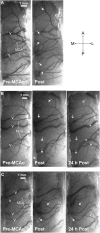Laser speckle contrast imaging of collateral blood flow during acute ischemic stroke
- PMID: 20517321
- PMCID: PMC2949243
- DOI: 10.1038/jcbfm.2010.73
Laser speckle contrast imaging of collateral blood flow during acute ischemic stroke
Abstract
Collateral vasculature may provide an alternative route for blood flow to reach the ischemic tissue and partially maintain oxygen and nutrient support during ischemic stroke. However, much about the dynamics of stroke-induced collateralization remains unknown. In this study, we used laser speckle contrast imaging to map dynamic changes in collateral blood flow after middle cerebral artery occlusion in rats. We identified extensive anastomatic connections between the anterior and middle cerebral arteries that develop after vessel occlusion and persist for 24 hours. Augmenting blood flow through these persistent yet dynamic anastomatic connections may be an important but relatively unexplored avenue in stroke therapy.
Figures


References
-
- Ayata C, Dunn AK, Gursoy-Ozdemir Y, Huang Z, Boas DA, Moskowitz MA. Laser speckle flowmetry for the study of cerebrovascular physiology in normal and ischemic mouse cortex. J Cereb Blood Flow Metab. 2004;24:744–755. - PubMed
-
- Dunn AK, Bolay H, Moskowitz MA, Boas DA. Dynamic imaging of cerebral blood flow using laser speckle. J Cereb Blood Flow Metab. 2001;21:195–201. - PubMed
Publication types
MeSH terms
Grants and funding
LinkOut - more resources
Full Text Sources
Other Literature Sources
Medical

